Tomato fritters (Ντοματοκεφτέδες)
Tomato fritters or domatokeftedes are a wonderful Greek meze that celebrate the fresh flavours of summer. Made with tomatoes, zucchini, onion, fresh herbs, flour, breadcrumbs and seasonings, these fritters are fried until golden. Every bite is a burst of flavour.
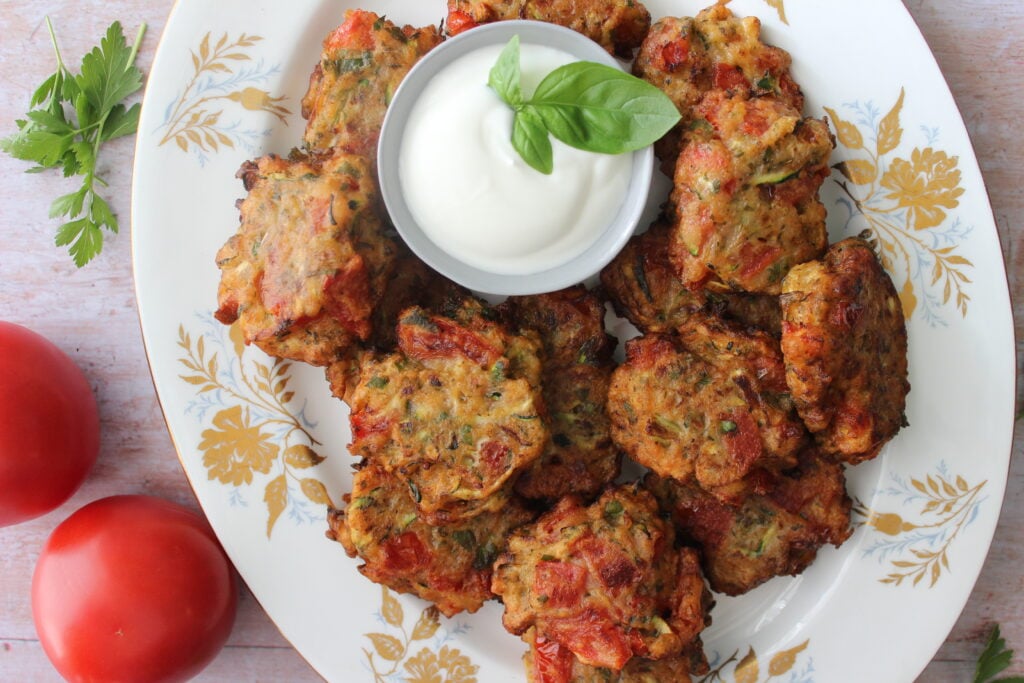
Growing up in a Greek home we ate a lot of vegetarian or vegan fritters, which are referred to as a composite of their primary ingredients and the word keftedes. Keftedes actually refers to meatballs, and anything that is meatball-like but which contains no meat is called pseftokeftedes (psefto means fake). This includes zucchini fritters (kolokithokeftedes), chickpea fritters (revanokeftedes) and baked squash fritters (also called kolokithokeftedes).
Why I love this recipe
If you’re longing to spend time in Greece but can’t get there this year, these tomato fritters may be the next best thing. Domatokeftedes, as they are called in Greek, are perfect bites of sunshine; an explosion of freshness and herb-y goodness in every bite. A taste of Greece, in the literal sense.
This recipe does not contain eggs or dairy, so they are perfect for periods of lent, and for vegans and vegetarians. It doesn’t hurt that these mezes (appetizers) are so easy to eat; two bites and they can be done, your hands free to pick up another.
Key ingredients
You need a few ingredients to make these tomato fritters, but trust me, they are totally worth it!
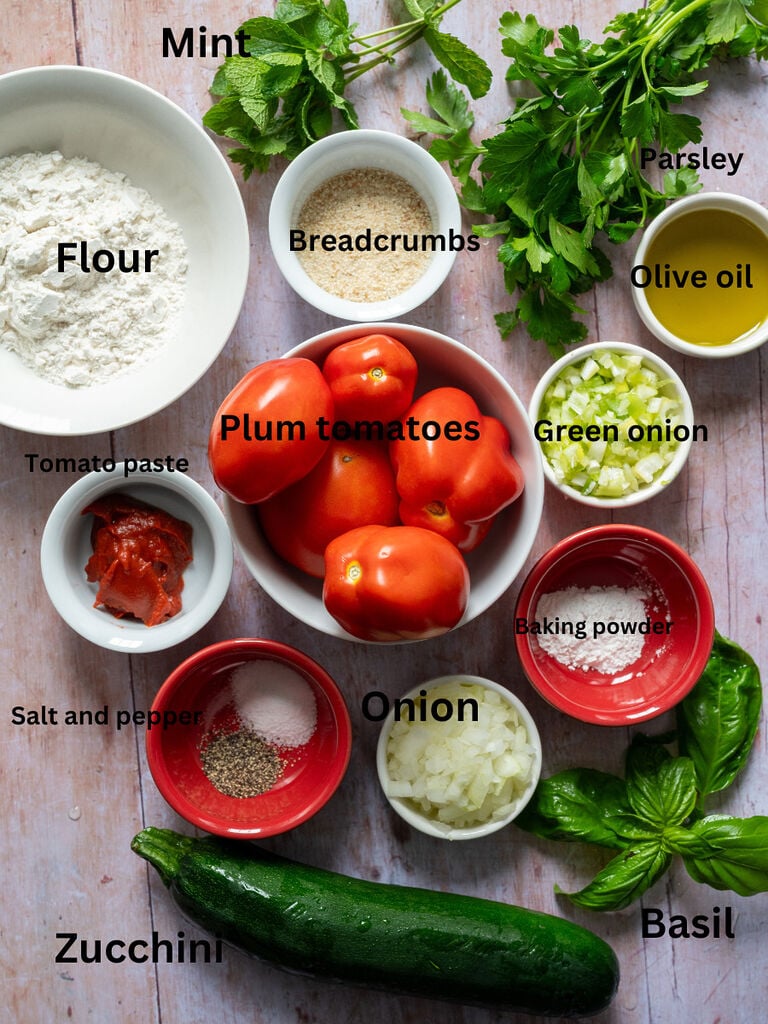
Tomatoes If you can get your hands on Santorini tomatoes, by all means, use those! But, unless you are on the island, you likely can’t so I use Roma or plum tomatoes instead. These tomatoes are a great substitute because they are firm and have a thick flesh which does not fall apart during the cooking process.
Grated zucchini To add flavour and body to the fritters I use grated zucchini. I don’t peel the zucchini, I just wash it well.
Onion I use yellow onion because if holds up well during cooking and has a mild, yet delicious flavour.
Green onion To complement the yellow onion I use green onion because it is fresh and peppery.
Herbs I use plenty of fresh and dry herbs in these fritters, including basil, mint, and parsley.
Tomato paste With its very concentrated tomato flavour and thick texture, tomato paste really helps enhance these fritters.
Flour All purpose or regular flour acts as a binder and helps to draw in some of the moisture of the vegetables so that they don’t fall apart.
Bread crumbs I also include bread crumbs, for the same reason as the flour, because I find that flour alone does not give the best final texture. I use plain breadcrumbs.
Baking powder A bit of baking powder give a bit of rise to these fritters.
Salt & pepper Basic seasonings! Everything tastes better with a little salt and pepper.
Olive oil for frying I use olive oil to fry these tomato fritters. I know that many people say not to fry in olive oil, but Greeks do it all the time!
How to make it
Making these tomato fritters is pretty easy, but still requires a bit of attention to detail. Follow the recipe steps carefully, and you will be fine!
Preparation
Ensure that your diced tomatoes are as “dry” as possible; meaning, you should remove all the seeds, and the pulp that they are found in. If your tomatoes still appear to have a lot of liquid, drain them in a fine sieve.
Use your hands or a cheesecloth to squeeze out as much liquid as possible from your grated zucchini.
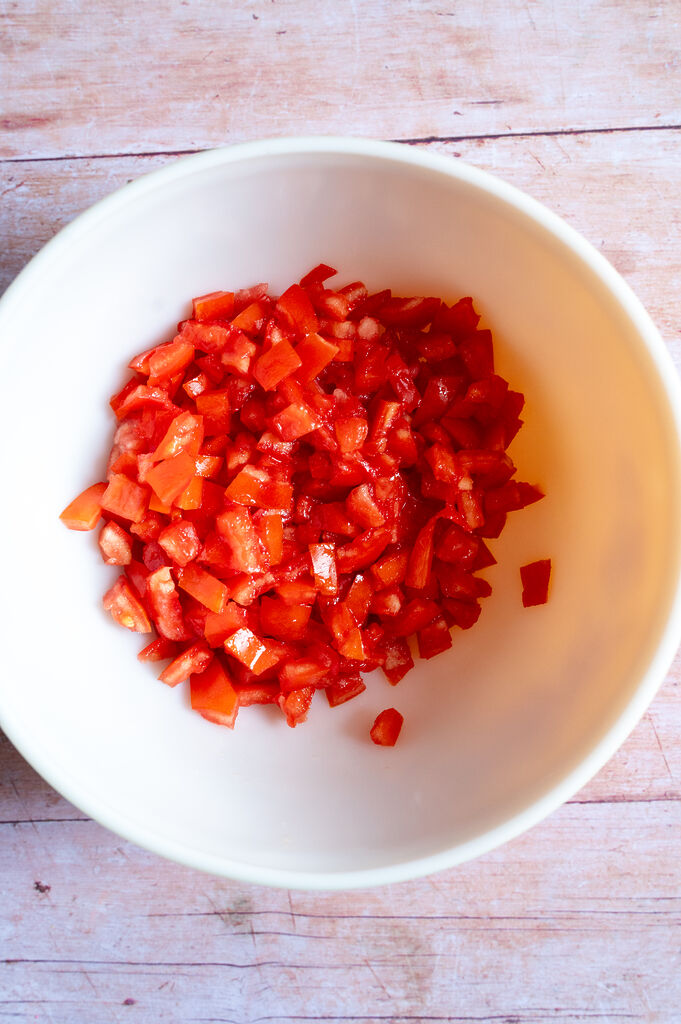
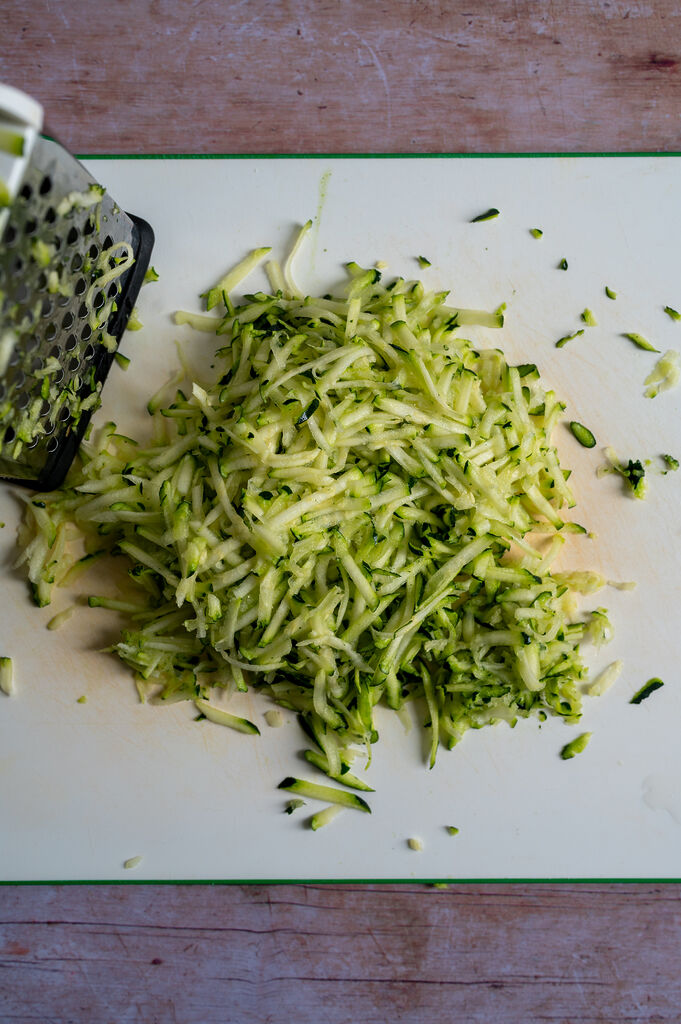
Instructions
Step 1
In a large mixing bowl combine the tomatoes, zucchini, onions (both the yellow onion and the green onion), tomato paste, parsley, basil, mint, salt and pepper. Mix well to combine.
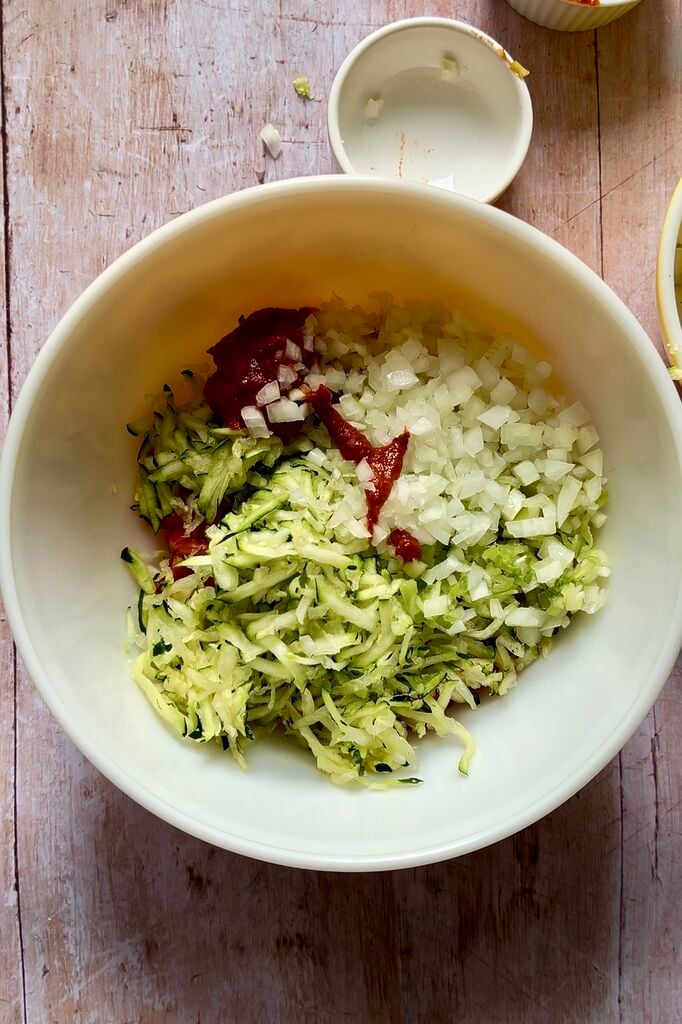
Step 2
In a smaller bowl, combine the flour, baking powder and breadcrumbs. Use a fork or whisk to combine well.
Step 3
Add the flour mixture to the vegetable and herb mix and stir well to combine. Set aside for 5 to 10 minutes.
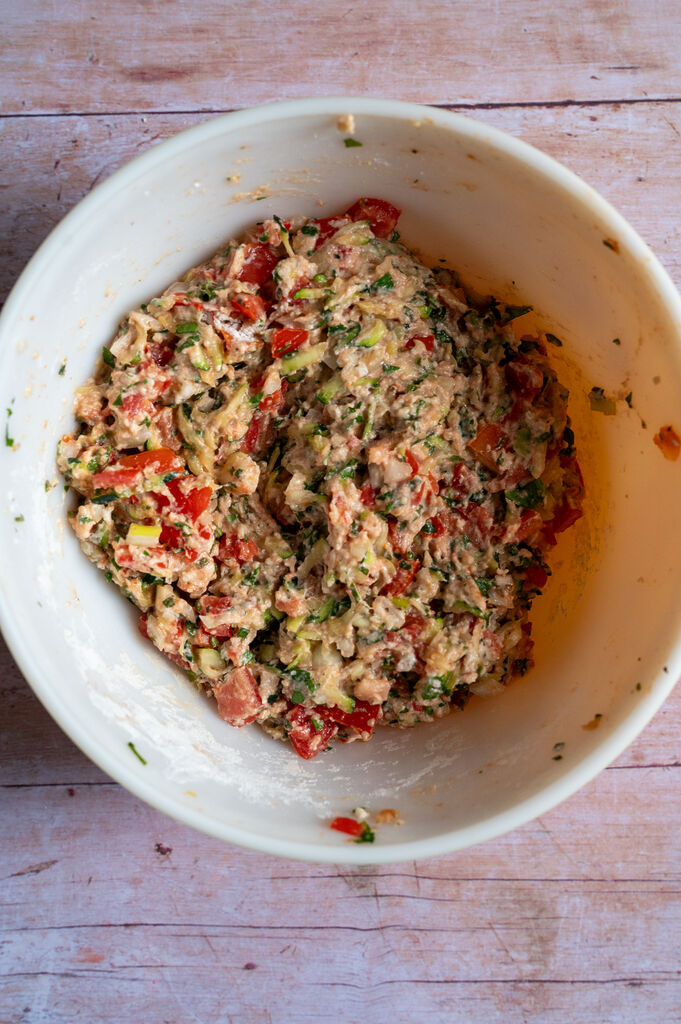
Step 4
After your mixture has sat for approximately 10 minutes give it another stir. It should hold together when you scoop some of the mixture out with a spoon.
Step 5
Heat approximately 1 – 2 centimeters of olive oil in a pan over medium heat (I like to use a non-stick pan).
Step 6
Use two spoons (I use tablespoons) to portion out the mixture for the fritters. Use the first spoon to scoop out the mixture and the second spoon to help shape it and to then slide it off the first spoon into the hot oil.
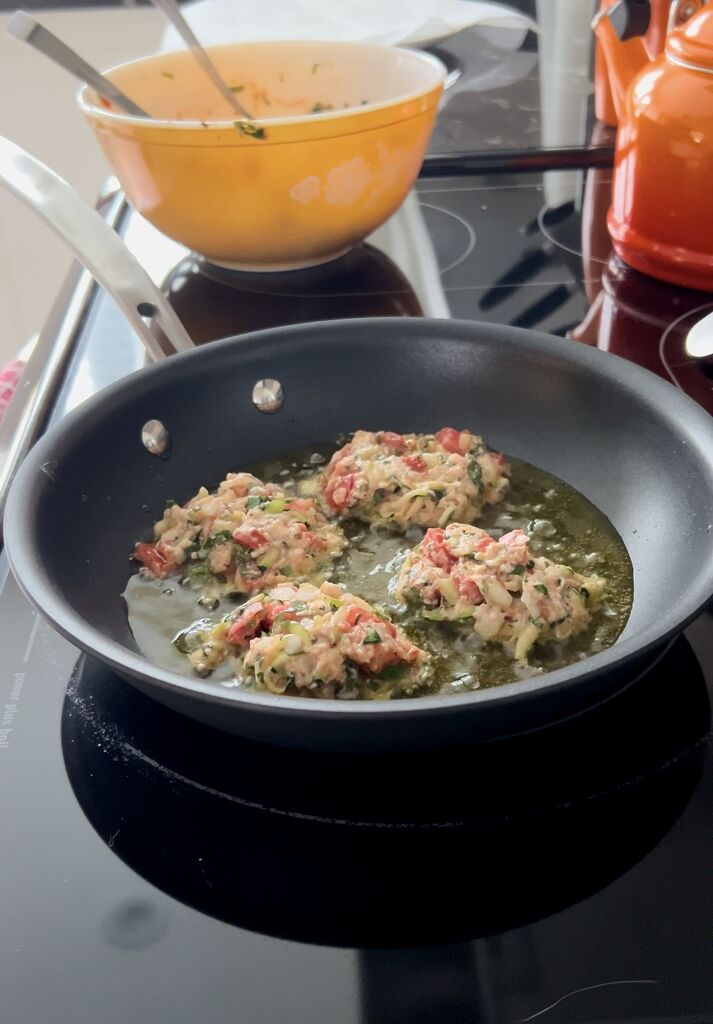
Step 7
Fry for 2 – 3 minutes until golden brown and then use two forks to flip your fritters over. Press down slightly and fry for an additional 2 – 3 minutes until golden brown on both sides and cooked through.

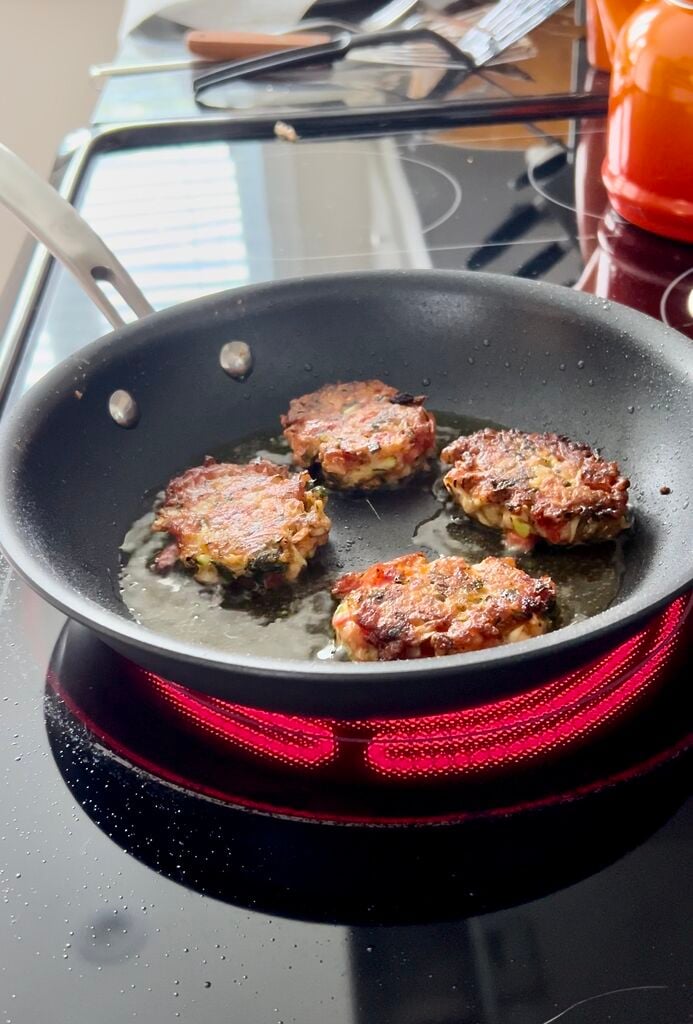
Step 8
Remove from the oil and drain on a paper towel lined plate. Allow to cool and then serve with a side of plain yogourt or tzatziki.
Recipe substitutions
You can substitute the herbs that are used in this recipe for others. Chives and oregano would be nice choices as well.
If you prefer to fry in vegetable oil, or another mild flavoured oil, you can do so.
I use plain breadcrumbs in my fritters, but if you have breadcrumbs that have cheese or herbs in them, you can use those as well.
Cooking tips and helpful hints
Keep your fritters from falling apart
It’s important to add the amount of flour required to bind your ingredients together. I use 1/2 cup all-purpose flour but if you feel you need a bit more, go ahead and add more, 1 tablespoon at a time. Go slowly; adding more flour than you need will produce a fritter which can be a bit mushy in the center.
After the fritters are cooked, allow them to cool on your paper towel lined plate before trying to serve them or eat them. If they are too warm they may fall apart.
Recipe variations
You can add half a cup of crumbled feta to the mixture to make delicious tomato fritters. These won’t be traditional (typically they contain no dairy) but they will be delicious!
You can also add a beaten egg to the mixture if you want to help with having all of the ingredients bind together.
How to serve
Although they are delicious on their own, they are also great when dipped into some tzatziki or plain yogourt. Otherwise, tomato fritters can be part of a Greek meze table, that can include things like Dolmades, Fried calamari and Fried zucchini chips. They can also be served as the side dish to a meat protein like Greek marinated chicken thighs or Pork souvlaki. Basically, any way you serve these amazing fritters is perfect!
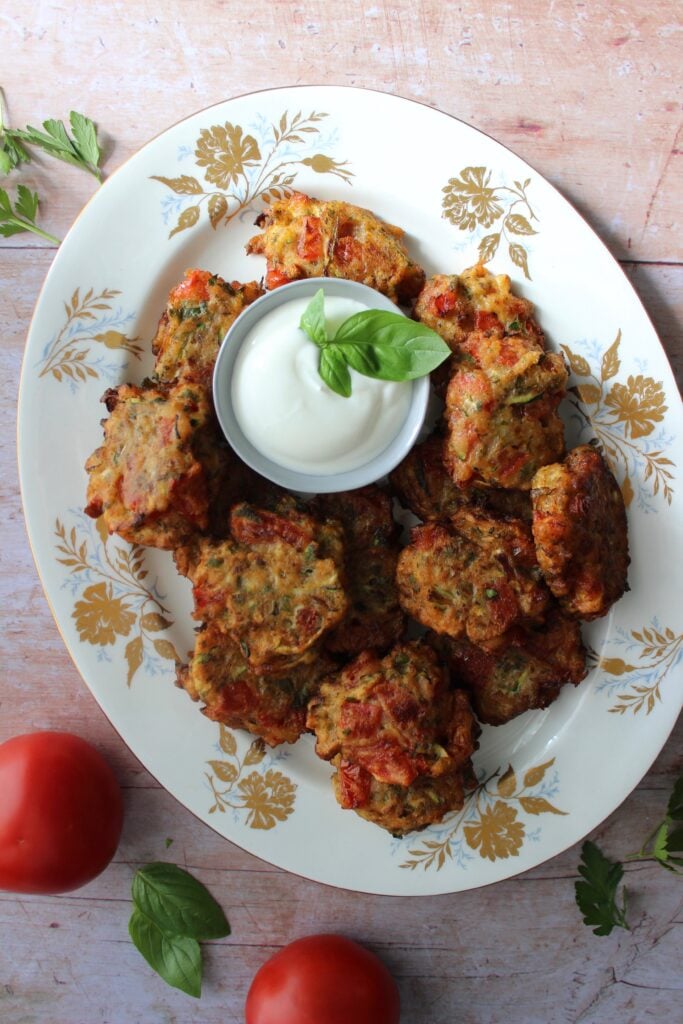
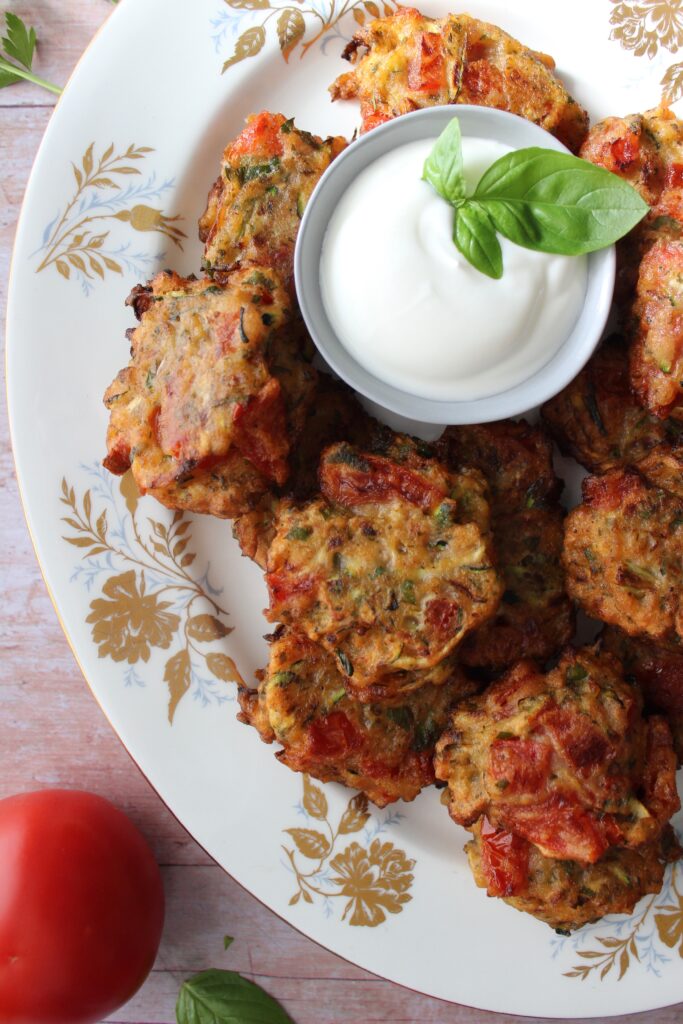
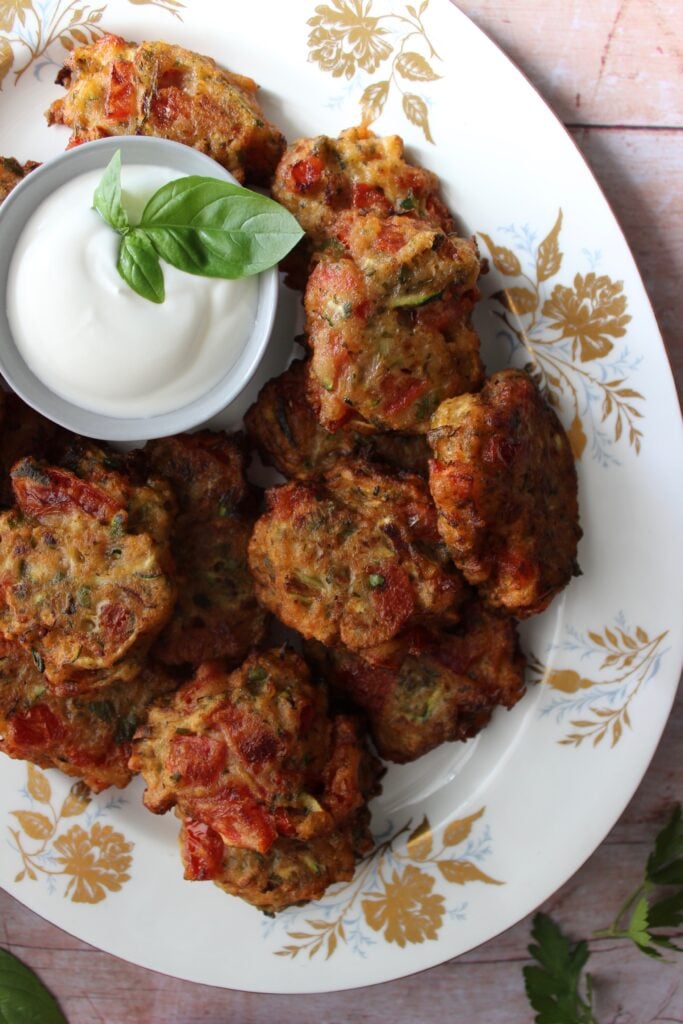
Frequently asked questions
What type of tomato should I use to make domatokeftedes?
I use plum or Italian (also called Roma) tomatoes for these fritters. This is because they tend to be less juicy than other tomato varieties and the flesh is relatively thick so they hold up quite well in the fritters. To enhance the tomato flavour you’ll note that there is also tomato paste included in the recipe. This enhances the rich tomato flavour and also helps to bind the various ingredients together.
Can I add an egg to help bind my tomato fritters?
You can, but you really should not have to. I chose to keep these domatokeftedes vegan and they work really well even without the egg for binding. At the same time, you’ll be the one enjoying these, so if you prefer to add an egg, go ahead!
Storing and reheating
Store leftover tomato fritters in the refrigerator in a covered container. They will keep for up to 3 days.
As with most fritters, reheating is tricky. You certainly don’t want to warm them up in the microwave because you will end up with a soggy meze. You can either re-heat them in the oven, or on an un-oiled or dry frying pan. An air fryer also works really well! Keep the temperature low (no higher than 300 degrees Fahrenheit) and air fry for about 5 minutes. But more importantly…how do you have any left over?
Why are domatokeftedes considered a special dish in Santorini?
The secret is in the tomato! Santorini cherry tomatoes are tiny marvels; so small that you may mistake them for small berries. The unique Santorini climate and geology allows these tomatoes to grow only there, as they have done since the year 1818 when the first seed was reportedly sown by a monk named Fragkiskos at the Capuchins Monastery. Their flavor and texture comes from a combination of things, including the soil which is replete with nutrients from volcanic ash.
Locally referred to as tomataki (or little tomato) their cultivation in Santorini flourished until the 1950s. Along with an earthquake in 1956, the largest threat to the farming of Santorini tomatoes resulted from the very thing that has so many of us falling in love with domatokeftedes in the first place – tourism. As farmers realized that the tourism industry was more lucrative than agriculture, fewer and fewer people devoted their lives and land to farming. Truly unfortunate as these tiny jewels have a slightly dry flesh, an intense aroma and a sweet taste all their own. They are so unique and special that since 2013 Santorini tomatoes have been classified as P.D.O. (Protected Designation of Origin) within the European labeling scheme.
The story behind this recipe
My parents have always made all sorts of fritters, some baked, some fried, some with cheese, others without, and all perfectly delicious. Domatokeftedes however entered our lives a little later. It all began when I took my first trip to Santorini. That idyllic Greek island known for its heart-stopping sunrises, quintessential landscape of white washed houses with sea blue roofs, and its remarkable volcanic setting. It’s got some pretty nice beaches too.
When back from paradise, and with Santorini memories still vivid, my parents heard me talk about the amazing domatokeftedes that were enjoyed on the island. About a week later, during a family dinner, the table was set buffet-style and there amidst the tzatziki, the moussaka and the horta was a platter piled high with these tomato fritters. They hadn’t said a word about them but watched as we all scanned their offerings, our eyes finally settling on this something new.
“Are those domatokeftedes?!” I exclaimed.
“They are!” my parents proudly responded, in unison.
“I didn’t know you knew how to make these!”
“What do you think? It’s hard? It’s not hard! Now taste, and tell us what you think.”
I took the first taste, as I was the one who had eaten the amazing tomato fritters in Santorini. Eyes closed, mouth slowly chewing and enjoying flavours that brought back a flood of happy moments. Sure, they weren’t quite the same. They weren’t made with the special Santorini tomatoes from the island, and the Greek breeze was not wrapping itself around me as I looked out onto the sea. Instead, when eyes opened, I was in my family kitchen, around a plastic covered table displaying food served on mismatched platters, with my parents waiting expectantly. These domatokeftedes didn’t taste like those in Santorini. They were just a little bit better.
Related recipes
If you are looking for more recipes similar to these domatokeftedes, then I think you will really like these other Greek fritters.
Revithokeftedes (chickpea fritters)
Kolokithokeftedes (zucchini fritters)

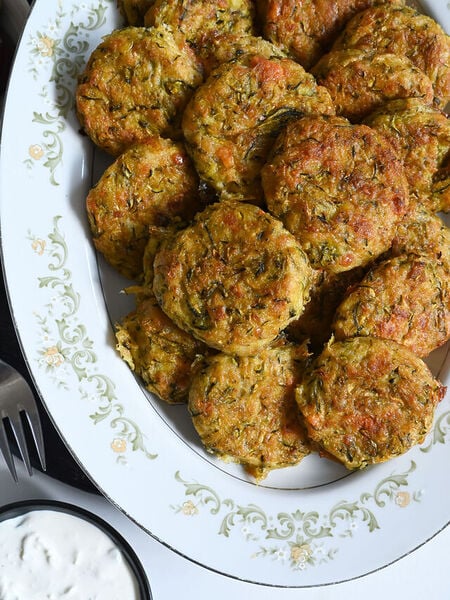



Tomato fritters (Ντοματοκεφτέδες)
Ingredients
- 2 cups seeded and diced plum tomatoes about 4 – 5 tomatoes
- 1 1/4 cups grated zucchini about 1 medium zucchini
- 1/4 cup diced onion about 1/2 a medium onion
- 1 green onion, diced
- 1 tbsp tomato paste
- 2 tbsp chopped parsley
- 4 – 5 fresh basil leaves
- 1 tbsp dry mint or 2 tbsp fresh mint, chopped
- 1 tsp salt
- 1/4 tsp ground black pepper
- 1/2 cup all-purpose flour
- 1 tsp baking powder
- 1 tbsp plain bread crumbs
- olive oil for frying
- plain Greek yogourt or tzatziki for serving optional
Instructions
- Ensure that your diced tomatoes are as "dry" as possible; meaning, you should remove all the seeds, and the pulp that they are found in. If your tomatoes still appear to have a lot of liquid, drain them in a fine sieve.2 cups seeded and diced plum tomatoes
- Use your hands or a cheesecloth to squeeze out as much liquid as possible from your grated zucchini.1 1/4 cups grated zucchini
- In a large mixing bowl combine the tomatoes, zucchini, onions (both the yellow onion and the green onion), tomato paste, parsley, basil, mint, salt and pepper. Mix well to combine.1/4 cup diced onion, 1 green onion, diced, 1 tbsp tomato paste, 2 tbsp chopped parsley, 4 – 5 fresh basil leaves, 1 tbsp dry mint, 1 tsp salt, 1/4 tsp ground black pepper
- In a smaller bowl, combine the flour, baking powder and breadcrumbs. Use a fork or whisk to combine well.1/2 cup all-purpose flour, 1 tsp baking powder, 1 tbsp plain bread crumbs
- Add the flour mixture to the vegetable and herb mix and stir well to combine. Set aside for 5 to 10 minutes.
- After your mixture has sat for approximately 10 minutes give it another stir. It should hold together when you scoop some of the mixture out with a spoon.
- Heat approximately 1 – 2 centimeters of olive oil in a pan over medium heat (we like to use a non-stick pan).olive oil for frying
- Use two spoons (we use tablespoons) to portion out the mixture for the fritters. Use the first spoon to scoop out the mixture and the second spoon to help shape it and to then slide it off the first spoon into the hot oil.

- Fry for 2 – 3 minutes until golden brown and then use two forks, or a spatula, to flip your fritters over. Press down slightly and fry for an additional 2 – 3 minutes until golden brown on both sides and cooked through.
- Remove from the oil and drain on a paper towel lined plate. Allow to cool slightly, then place on a rack to cool completely. Serve with a side of plain yogourt or tzatziki.plain Greek yogourt or tzatziki for serving
- Enjoy!

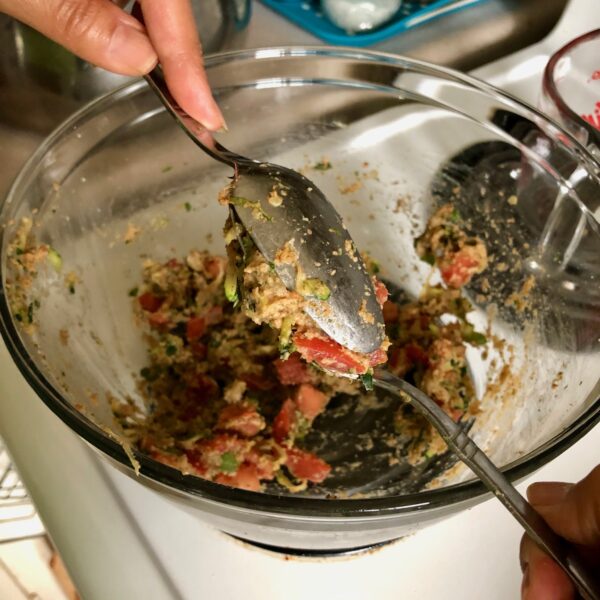
You are fantastic thank you every recipe you put i love.
Thank you so much 🙂
These look so yummy! Is it possible to bake in the oven or cook in an air fryer??
Hi Vasso, you can probably do either. Since we have not made them that way we can’t really give you too much specific advice, but you can use our recipe for baked kolokithokeftedes for inspiration. Hope that helps, Helen & Billie